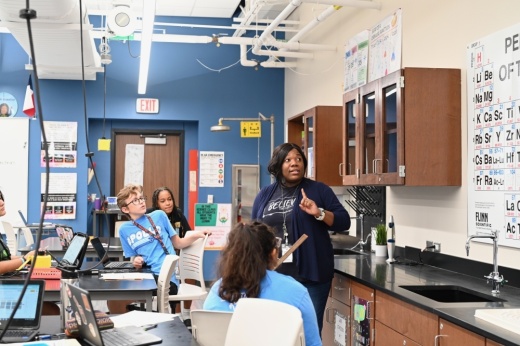To improve its financial situation, RISD officials are exploring several potential solutions, including increasing student enrollment by allowing more students outside the district to register, advocating for more state funding and trimming costs, both by removing positions and potentially cutting programs throughout the district.
Heading into FY 2023-24, district officials expect the deficit to grow to around $15.8 million.
The deficit is a result of reduced enrollment, inflation and a lack of new funding from the state since before the pandemic, Superintendent Tabitha Branum said during the meeting.
The issues are not unique to RISD, as many districts across the state are facing similar concerns, according to Bob Popinski, senior director of policy of Raise Your Hand Texas, an educational advocacy nonprofit.
“Double-digit inflation ... has led to increased costs of operating school districts,” Popinski said. “We’ve also seen districts trying to raise teacher salaries to keep pace with inflation, leading to a loss in buying power.”
This year, RISD trustees approved a salary increase for teachers and staff members to help with recruitment and retention that will cost more than $20 million if the district is fully staffed.
The measure increased starting teacher salaries to $60,000, while returning teachers would receive a 5.75%-8% salary increase, depending on experience. No decision has been made on whether to use the district’s $170 million balance from the general fund to offset the budget deficit.
A large factor in the 2022-23 budget deficit RISD is facing is a lack of state funding, Branum said. According to Raise Your Hand Texas officials, the per-student basic allotment of $6,160 provided by the state to school districts has not increased since 2019.
Meanwhile, from June 2019 to February 2023, inflation in Texas increased 17%, according to the U.S. Bureau of Labor Statistics. As a result, the state’s Legislative Budget Board estimated in 2022 that school funding was at 2014 levels when adjusted for inflation.
Adding enrollment
Increasing enrollment is a top priority for RISD’s FY 2023-24 budget as it’s a major factor in the district’s state funding formula.
According to a report by educational consulting firm Davis Demographics, enrollment within RISD’s boundaries has decreased by over 2,000 students since 2019. In the 2022-23 school year, RISD had 36,232 students enrolled within its boundaries. The report also stated in-boundary enrollment is expected to continue decreasing over the next decade, with the 2032-33 school year having a projected enrollment of under 30,000. State officials set the operating tax rate annually that districts can collect based on a formula that includes the number of students attending school each day and assessments of property values within a district.
In March, RISD trustees discussed creating an open-enrollment program that would increase enrollment of students outside the district.
According to district officials, RISD has nearly 9,400 seats available at its elementary schools. At the basic state allotment, filling those seats would provide the district with almost $69 million in state revenue.
“I think having a conversation about how public schools can transfer students between districts is important to have,” Popinski said. “We want to make sure that school districts are able to ... have enough [students] and enough quality teachers in place.”
Cutting costs
To be financially flexible, the RISD board began seeking to cut costs in early 2023 while staying away from cutting programs that affect students.
According to David Pate, RISD assistant superintendent of finance and support services, district officials reduced expenses during FY 2022-23 by $1.2 million by eliminating 14 administrative positions and cutting staff for its English as a second language program. Pate said the district expects to see around $3.7 million in additional cost saving measures in FY 2023-24. To find more ways to save costs, RISD trustees plan to create a community steering committee for input on the FY 2024-25 budget.
The committee would begin meeting in July, and work to review programming options and district-operated services. Branum said the committee is expected to present findings in late 2023.
“We need to hear from our community and from our staff on how we prioritize programs,” Branum said.
One area where district officials are forced to spend is the state’s recapture allocation. Recapture redistributes local excess property taxes from districts to those deemed “property poor” by the Texas Education Agency. According to the TEA’s Recapture Cost report, RISD is expected to send over $4 million from its collected property tax to the state for FY 2022-23.
While RISD continues to send money to the state annually, it has also been pushing legislators to use an estimated $32 billion budget surplus to assist public education.
According to RISD officials, legislative discussions didn’t reflect the true rise of inflation to increase the basic allotment by at least $900 per student.
“We had hoped that this was going to be a legislative session that was going to provide a little bit more [funding] relief,” Branum said. “Even with that in mind, we knew that it would not solve all of the financial challenges that we have.”Since the start of the pandemic, Richardson ISD has faced challenges in balancing its budget, with the district facing a financial deficit of around $15 million in fiscal year 2022-23.





